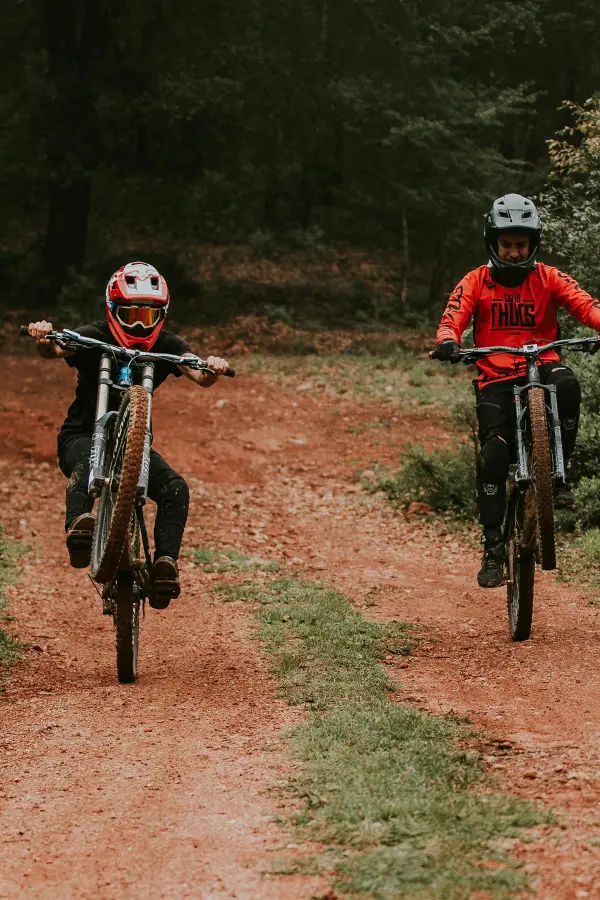Crashing is part of cycling as crying is part of love.
Johan Museeuw
- The Lion of Flanders
Crashing is part of cycling as crying is part of love.
Johan Museeuw
- The Lion of Flanders

Conquer the Mountain. Find Your Freedom.

Conquer the Mountain. Find Your Freedom.

Mountain biking is an exhilarating sport that takes cycling off traditional roads and onto rugged trails through forests, mountains, and deserts. It blends the challenges of rough terrain with the joy of fitness and the freedom of being in nature. Originating in the 1970s in Marin County, California, it has evolved into a globally recognized sport with various disciplines for all levels of riders.
According to the 2023 Outdoor Participation Trends Report, mountain biking is experiencing a robust annual growth rate of 6.5% in the US. Let’s explore some of the most popular mountain biking categories driving this surge.
Cross-Country (XC) mountain biking is highly popular due to its accessibility and versatility. It appeals to a broad range of riders, from recreational enthusiasts to competitive athletes. XC biking offers a great way to enjoy nature while getting a robust workout, and it’s a common entry point for those new to mountain biking.
Its inclusion in major competitions like the Olympics has also elevated its status in the mountain biking community. XC involves covering long distances over varied terrain, emphasizing endurance, speed, and technical skill.
Characteristics:

Downhill (DH) biking’s high popularity stems from its thrilling and adrenaline-pumping nature. It attracts those who love speed and the challenge of navigating steep, technical descents. The excitement of gravity-assisted riding and the spectacle of downhill races make it a favorite among both participants and spectators.
Its prominent presence in competitive events like the UCI Downhill World Cup further boosts its appeal. DH focuses on high-speed descents on steep, technical trails with challenging obstacles.

Characteristics:
Trail riding is popular because it offers a balanced and enjoyable mountain biking experience. It’s less intense than cross-country or downhill but still provides plenty of excitement and variety. Trail riding is perfect for those who enjoy exploring diverse landscapes without the need for extreme technical skills or physical fitness.
It’s accessible to a wide audience and is often seen as a more relaxed and recreational form of mountain biking. It involves riding on varied terrain, including singletrack, fire roads, and technical sections, suitable for all skill levels.
Characteristics:
Enduro’s popularity is driven by its combination of downhill thrills and cross-country endurance challenges. Riders appreciate the varied demands of this discipline, which tests both technical descending skills and the physical endurance required for uphill sections.
The competitive nature of enduro races, with their timed downhill stages, attracts serious cyclists looking for a comprehensive test of their abilities. The Enduro World Series has helped popularize this discipline worldwide. Combines timed downhill stages with untimed uphill sections, emphasizing both technical and endurance riding.
Characteristics:

Freeride appeals to riders who enjoy the creative and daring aspects of mountain biking. It’s popular due to the freedom it offers to perform tricks, jumps, and technical maneuvers. The dramatic and visually impressive nature of freeride, often showcased in extreme sports media and competitions, attracts many thrill-seekers and stunt enthusiasts.
Its focus on style and personal expression makes it a favorite among younger riders and those looking to push the limits. Focuses on performing jumps, drops, and tricks on diverse terrain, emphasizing creativity and technical skill.
Characteristics:
All-mountain biking’s popularity comes from its comprehensive approach to mountain biking, blending elements of cross-country and downhill. It’s favored by riders who enjoy a bit of everything, from climbing and descending to technical sections and exploring rugged trails.
This discipline suits those who seek adventure in varied terrains and prefer a well-rounded mountain biking experience. However, it’s not as specialized or widely recognized as some other disciplines, which affects its overall popularity. It encompasses a mix of climbs, descents, and technical sections, suitable for exploring diverse terrains.
Characteristics:
Four-cross (4X) and Dual Slalom are popular for their competitive and spectator-friendly nature. These disciplines involve head-to-head racing on short, obstacle-filled tracks, which makes for exciting and dynamic events.
Their popularity is boosted by the fast-paced, action-packed racing format that appeals to both participants and viewers. However, their niche nature and the need for specialized tracks limit their widespread adoption. Features head-to-head racing on short courses with obstacles like jumps and berms, emphasizing speed and precision.

Characteristics:
Dirt jumping’s popularity is due to its focus on aerial stunts and the thrill of performing jumps on specially designed dirt tracks. It attracts riders who enjoy showcasing their skills and pushing the boundaries of what’s possible on a bike.
The visually impressive nature of dirt jumping and its appeal to the BMX and freestyle communities contribute to its popularity. However, it’s less accessible for casual riders due to the need for specific skills and facilities. Involves performing tricks and jumps on dirt tracks with large ramps, emphasizing aerial maneuvers and style.
Characteristics:

Trials riding is popular among those who enjoy technical challenges and the precision required to navigate obstacles. It appeals to a niche group of riders who focus on balance, control, and skill rather than speed.
The unique demands of trials riding, which require patience and practice, attract dedicated enthusiasts but limit its broader appeal. Focuses on navigating obstacles without touching the ground with feet, emphasizing balance and control.
Characteristics:
Urban or street mountain biking is popular for its adaptability and the creative use of urban environments. It attracts riders who enjoy exploring and performing tricks in city landscapes, using everyday structures as obstacles and features.
This discipline’s appeal lies in its accessibility and the freedom to ride almost anywhere, though it often overlaps with BMX and skateboarding cultures, which can dilute its identity as a distinct form of mountain biking. Involves riding in urban areas, using city features like stairs and rails to perform tricks and navigate obstacles.

Characteristics:
Marathon mountain biking is less popular due to the extreme endurance and physical demands required for long-distance races. It attracts serious athletes and long-distance enthusiasts who are willing to commit to rigorous training.
While it offers a significant challenge and a sense of accomplishment, its appeal is limited by the intense level of fitness and preparation needed, making it less accessible to casual riders. Involves long-distance racing over varied terrain, emphasizing endurance and stamina.
Characteristics:
Bikepacking is gaining popularity among adventure seekers who enjoy combining cycling with camping. It appeals to those who love exploring remote areas and experiencing nature over multiple days.
The growing interest in sustainable travel and outdoor adventures contributes to its rising popularity, though it remains a niche activity due to the need for specialized gear and the commitment required for long journeys. Combines mountain biking with overnight camping, allowing for exploration of remote areas over extended periods.
Characteristics:
Fatbiking is popular in regions with extreme terrains, like snow and sand, where traditional mountain bikes struggle. It appeals to riders looking for a unique challenge and the ability to ride in off-season conditions.
While its versatility and ability to handle difficult terrain are attractive, fatbiking remains a niche activity due to the specialized equipment required and its limited application compared to other forms of mountain biking. Involves riding on oversized tires designed for soft and unstable terrain like snow and sand.
Characteristics:

Mountain biking is more than just a thrilling adventure; it offers a wealth of benefits that enhance your physical, mental, and social well-being. Here’s why mountain biking is the ultimate activity for shredding stress, building strength, and fostering community!
Mountain biking provides a holistic workout that goes beyond mere exercise. As you power up hills and navigate rugged trails, your legs burn with the satisfying exertion of a full-body workout. This dynamic activity engages various muscle groups, including your legs, core, and upper body, building strength and endurance.
The cardiovascular benefits are profound, as the varied terrain demands continuous adaptation, boosting heart health and calorie burning. Each ride presents new challenges, ensuring a dynamic and effective exercise regimen.
For those with hectic schedules, mountain biking offers an efficient and invigorating way to stay fit. Just a 30-minute ride can provide a high-intensity workout that fits into even the busiest of days. It’s a quick escape from the gym, offering a chance to exercise while enjoying the outdoors, making it easier to stick to a fitness routine despite time constraints.
Mountain biking shattered my boring exercise routine! Hitting the trails is an adventure – you never know what awaits: a thrilling climb, a close encounter with wildlife (like snakes or boars!), or even friendly faces to share a post-ride beer with.
Engaging in mountain biking allows you to immerse yourself in nature, providing a powerful antidote to stress. It’s a chance to escape the daily grind and immerse yourself in nature’s symphony.
The fresh air and challenging terrain act as natural stress relievers and mental rejuvenators. Serene and scenic trails offer an ideal escape, fostering peace and mental clarity. The concentration required to navigate the trails serves as a form of active meditation, clearing the mind and enhancing mental resilience.
For busy individuals, mountain biking offers a quick and effective way to clear the mind and reduce stress. Even short rides can provide a significant mental boost, helping you return to your tasks with renewed focus and energy. It’s a productive break that not only recharges your mental batteries but also improves your overall outlook on life.
The daily grind melts away as I hit the trails. It’s just me, the bike, and the path ahead – pure freedom for the mind and body.
Mountain biking is not just a solo adventure; it’s a social experience that connects you with like-minded enthusiasts. Hit the trails with friends, share stories around a post-ride bonfire, and support each other through tricky sections.
Mountain biking fosters a supportive community, offering numerous opportunities to connect through group rides, clubs, and events. These interactions build a sense of community, providing support, motivation, and the joy of shared experiences.
Whether you’re learning new skills or exploring new trails, the camaraderie within the mountain biking community enhances the overall experience.

For those with limited free time, mountain biking is a fantastic way to combine socializing and exercising. Group rides or organized events offer a chance to catch up with friends or meet new people, making it easier to maintain social connections despite a busy lifestyle. It’s a two-in-one activity that enriches your social life while keeping you active.
Hitting the trails with my coworkers after work has been a game-changer. We’re a lot more productive and have a much tighter team now.
Mountain biking fosters a deep respect for nature. As you navigate through breathtaking landscapes, you develop a greater appreciation for the environment. Mountain biking inspires a commitment to preserving these natural playgrounds.
Riders often develop a heightened awareness of environmental issues and a dedication to conservation efforts. Many mountain bikers become advocates for trail preservation and responsible outdoor practices, promoting sustainability and environmental stewardship.
For busy individuals, mountain biking provides a meaningful way to connect with nature, even in short bursts. It’s a quick escape that helps you appreciate the environment and fosters a sense of stewardship, encouraging you to support conservation efforts even with limited time. It’s a rewarding way to balance a busy life with a commitment to preserving natural spaces.
I never knew being in nature was fun. City sirens replaced by the rustle of leaves, I finally understood. There’s a world of peace and purpose beyond the daily grind.
Mountain biking is more than just conquering rugged terrain on two wheels. It’s a gateway to a world of exhilarating adventure, physical challenge, and profound connection. It’s a dance with nature, pushing your physical limits while immersing yourself in the beauty of the outdoors.
It’s a social lubricant, forging bonds with fellow riders through shared experiences and camaraderie. It’s a mental escape, offering a refuge from daily stress and a path to mindfulness.
But ultimately, mountain biking is what you make it. It can be a competitive pursuit, a test of skill and endurance. It can be a leisurely exploration, a chance to unwind and reconnect with nature. It can be a social gathering, a way to build friendships and share stories.
Inspired to hit the trails? What kind of mountain biker will you be? Share your goals and dreams in the comments below! Next up, we’ll guide you on how to get started in mountain biking!